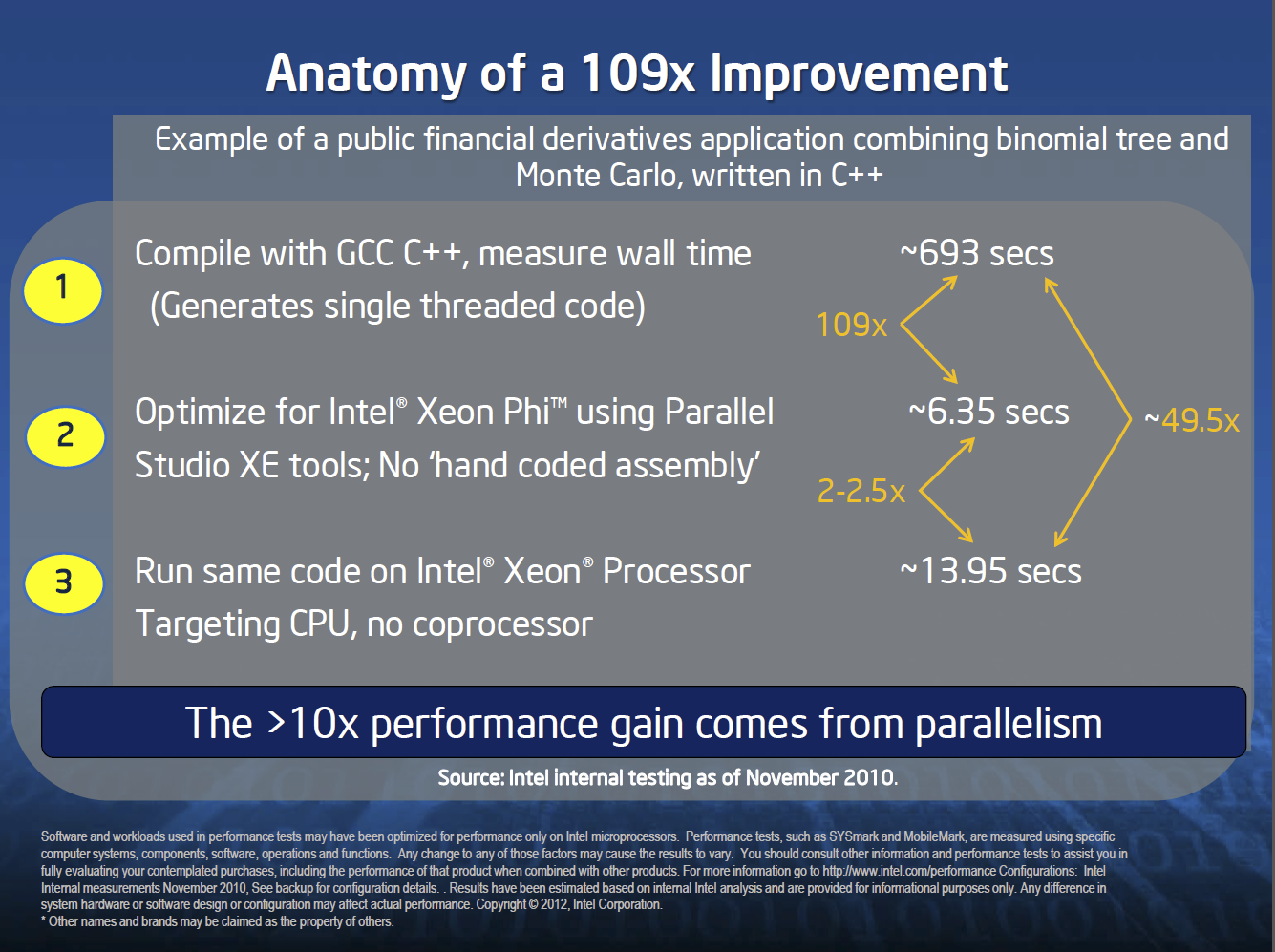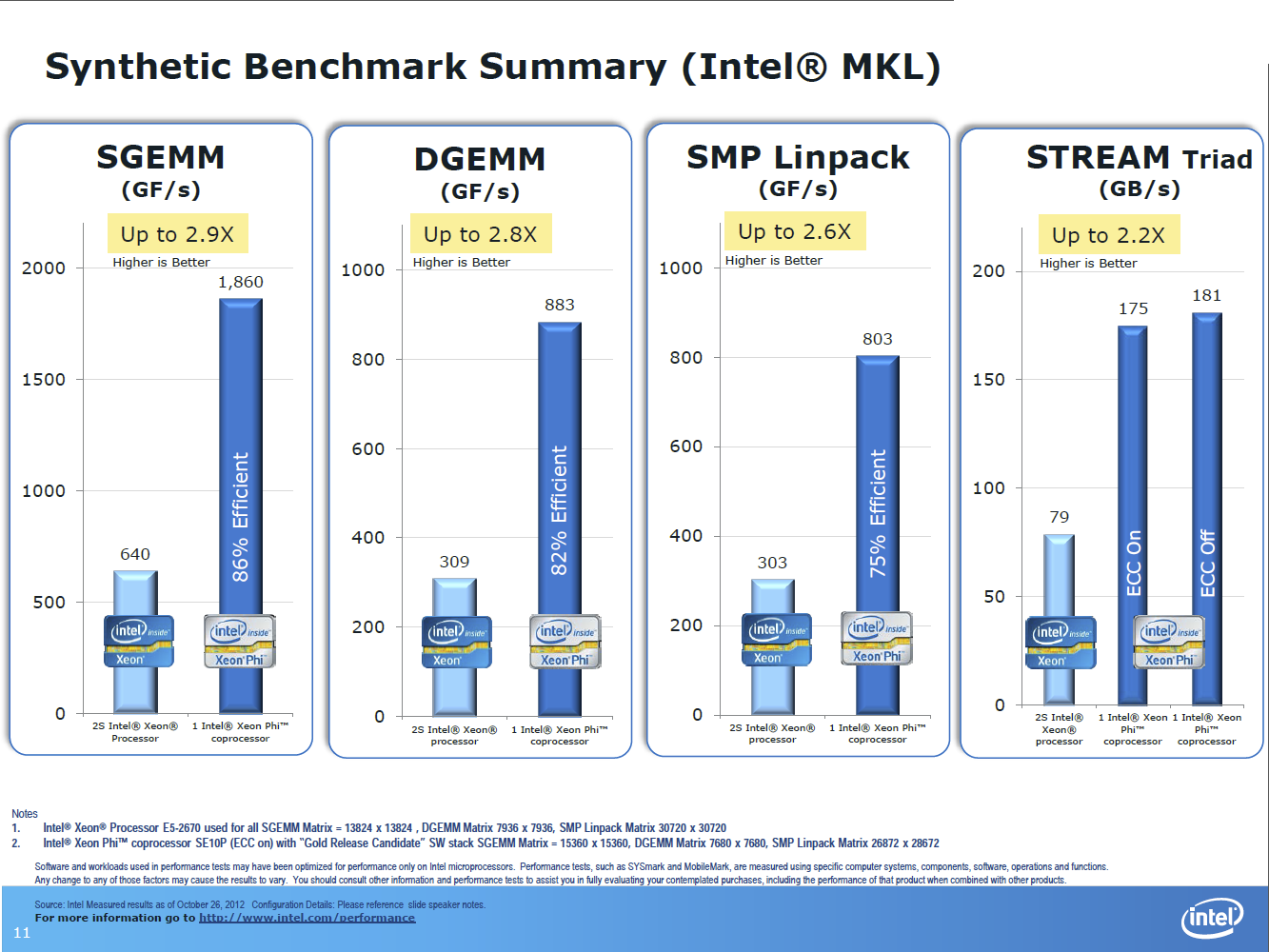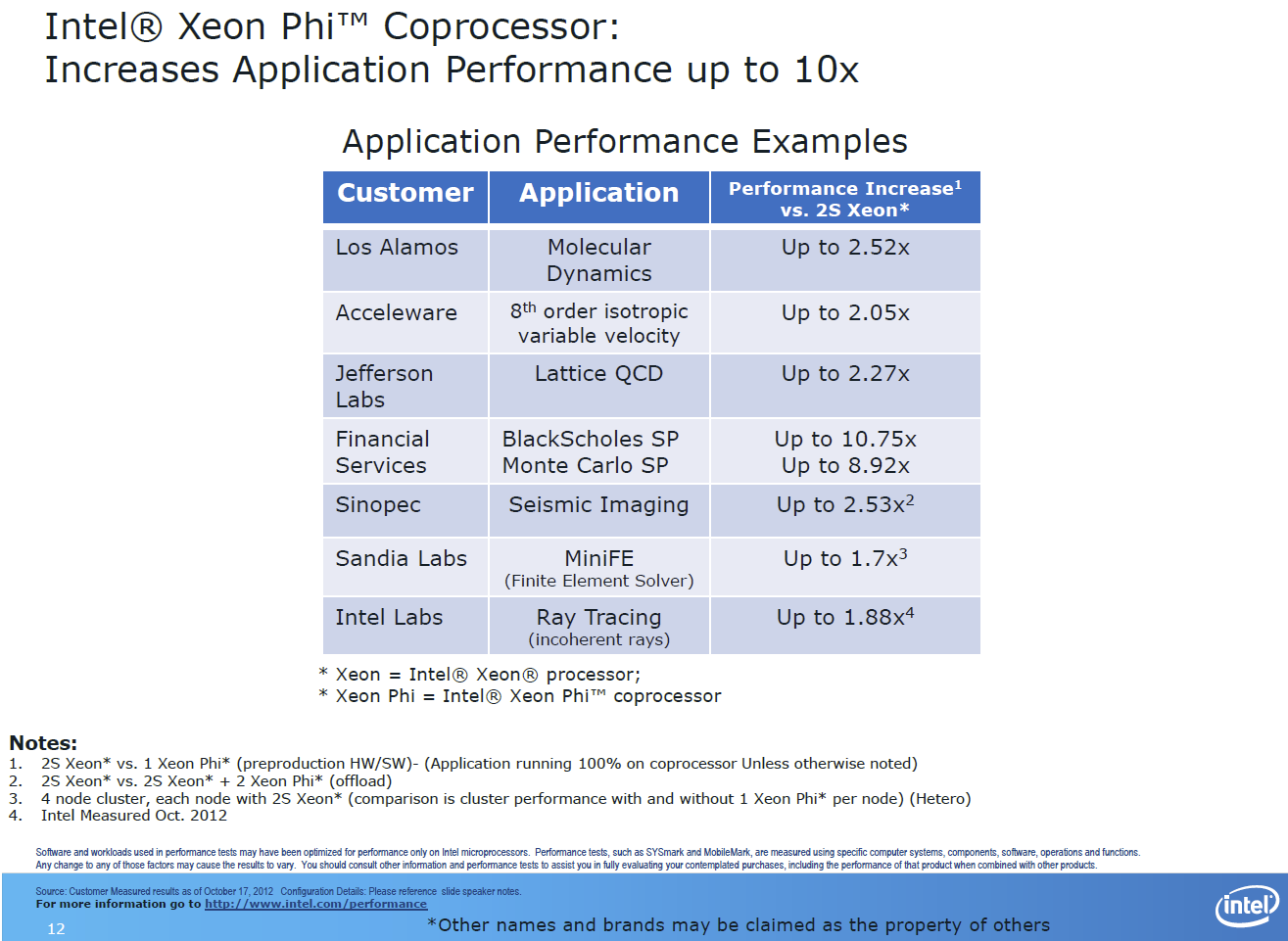Xeon Phi: Intel's Larrabee-Derived Card In TACC's Supercomputer
After eight years of development, Intel is finally ready to announce its Xeon Phi Coprocessor, which is derived from the company's work with Larrabee. Although the architecture came up short as a 3D graphics card, it shows more promise in the HPC space.
Intel Xeon Phi Performance
Throughout its press day, Intel repeated over and over the importance of optimized core when comparing the performance of a CPU to an accelerator. One of the company's first examples involved a bit of Fortran code. First, we saw results from the unoptimized single-threaded code, followed by a simple Xeon Phi port. The difference showed the Phi to be somewhere around 300x faster. Then, the Intel team demonstrated why its first comparison was flawed. When the same code was re-run on dual Xeon E5s, the Phi was only about twice as fast.
The purpose of this exercise seemed to be expectation management. It's in the best interest of companies like Nvidia to run parallelized code in a single thread as a baseline, and then run the same code on a graphics processor to claim more than two orders of magnitude improvement. But if you allow optimized code to take advantage of a multi-core CPU's resources, the real delta between them is much smaller.
Then, Intel shared some of the real-world performance improvements seen from comparisons between dual-socket Xeon-based machines and Xeon Phi.
Financial services professionals are probably salivating at these numbers. Monte Carlo models are often used to solve problems using a bunch of unknown inputs and probability. I've personally used them to suggest the risk and financial impact of large projects and product programs. And, after the 2001 dot-com crash, Black-Scholes became a preferred option valuation method. This was a huge deal in the mid-2000s because Silicon Valley companies that gave employees options instead of higher salaries were under increased pressure to pin a value on those options.
Intel also brought in representatives from Altair, a software and technology provider, to suggest how easy it was for them to port code to the Xeon Phi architecture and show examples of workloads like crash test simulations, which generally saw a 2.5x performance improvement.
In lieu of hardware and software we can test ourselves, Intel's discussion of performance is plausible. Optimization can move the needle in one direction or the other, and certain applications are going to realize more gain from what Intel is doing with Xeon Phi than others. But, with that said, a 2-2.5x improvement seems reasonable in environments able to benefit from parallelized computing.
Get Tom's Hardware's best news and in-depth reviews, straight to your inbox.
Current page: Intel Xeon Phi Performance
Prev Page Intel Xeon Phi Hardware Next Page The Value Proposition Of Xeon Phi: Optimization-
mocchan Articles like these is what makes me more and more interested in servers and super computers...Time to read up and learn more!Reply -
wannabepro Highly interesting.Reply
Great article.
I do hope they get these into the hands of students like myself though. -
ddpruitt Intriguing idea....Reply
These X86 cores have the uumph to run something a little more complex than what a GPGPU can. But is it worth it and what kind of effort does it require. I'd have to disagree with Intel's assertion that you can get used to it by programming for an "i3". Anyone with a relatively modern graphics card can learn to program OpenCL or CUDA on there own system. But learning how to program 60 cores efficiently (or more) from an 8 core (optimistically) doesn't seem reasonable. And how much is one of these cards going to run? You might get more by stringing a few GPUs together for the same cost.
I'm wonder if this is going to turn into the same time of niche product that Intel's old math-coprocessors did. -
CaedenV man, I love these articles! Just the sheer amounts of stuffs that go into them... measuring ram in hundreds of TBs... HDD space in PBs... it is hard to wrap one's brain around!Reply
I wonder what AMD is going to do... on the CPU side they have the cheaper (much cheaper) compute power for servers, but it is not slowing Intel sales down any. Then on the compute side Intel is making a big name for themselves with their new (but pricy) cards, and nVidia already has a handle on the 'budget' compute cards, while AMD does not have a product out yet to compete with PHI or Tesla.
On the processor side AMD really needs to look out for nVidia and their ARM chip prowess, which if focused on could very well eat into AMD's server chip market for the 'affordable' end of this professional market... It just seems like all the cards are stacked against AMD... rough times.
And then there is IBM. The company that has so much data center IP that they could stay comfortably afloat without having to make a single product. But the fact is that they have their own compelling products for this market, and when they get a client that needs intel or nvidia parts, they do not hesitate to build it for them. In some ways it amazes me that they are still around because you never hear about them... but they really are still the 'big boy' of the server world. -
A Bad Day esrevermehReply
*Looks at the current selection of desktops, laptops and tablets, including custom built PCs*
*Looks at the major data server or massively complex physics tasks that need to be accomplished*
*Runs such tasks on baby computers, including ones with an i7 clocked to 6 GHz and quad SLI/CF, then watches them crash or lock up*
ENTIRE SELECTION IS BABIES!
tacoslavei wonder if they can mod this to run games...
A four-core game that mainly relies on one or two cores, running on a thousand-core server. What are you thinking? -
ThatsMyNameDude Holy shit. Someone tell me if this will work. Maybe, if we pair this thing up with enough xeons and enough quadros and teslas, we can connect it with a gaming system and we could use the xeons to render low load games like cod mw3 and tf2 and feed it to the gaming system.Reply -
mayankleoboy1 Main advantage of LRB over Tesla and AMD firepro S10000 :Reply
A simple recompile is all thats needed to use PHI. Tesla/AMD needs a complete code re write. Which is very very expensive .
I see LRB being highly successful. -
PudgyChicken It'd be pretty neat to use a supercomputer like this to play a game like Metro 2033 at 4K, fully ray-traced.Reply
I'm having nerdgasms just thinking about it.


